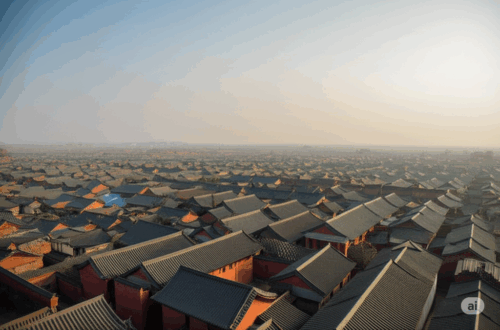Today, as you go about your day – perhaps sorting laundry, brewing coffee, or tackling your to-do list – take a moment to consider the very ground beneath your feet. It feels solid, dependable, unchanging, right? But delve into the annals of history, and you’ll find that even the most steadfast realities can be profoundly altered in an instant.
On this very date, a long, long time ago – specifically, let’s journey back to January 23rd, 1556 – something truly monumental happened in Shaanxi province, China. It wasn’t a battle between empires, a coronation of a new ruler, or the unveiling of a groundbreaking invention. Instead, the earth itself unleashed a fury so immense that it etched its mark indelibly onto the tapestry of human history.
The Shaanxi earthquake of 1556 is not just another date in a history book; it stands as the deadliest earthquake ever recorded. Imagine a tremor so violent that it instantly flattened an area spanning hundreds of miles. Picture entire villages collapsing in mere seconds, burying homes, temples, and countless lives under tons of loess soil – the fine, yellowish sediment that characterizes the region. Eyewitness accounts, though scarce and often filtered through the lens of the time, speak of unimaginable devastation, of mountains seeming to shift, of rivers changing course, and of a sky choked with dust that blotted out the sun for days.

The scale of the tragedy is staggering. While precise figures are difficult to ascertain from that era, estimates suggest that the death toll reached upwards of 100,000 people. Entire families were lost, their histories and futures extinguished in the blink of an eye. Cities that had stood for centuries were reduced to rubble, and the social and economic fabric of the region was torn apart.
Now, you might be thinking, “That’s a horrific event, but what on earth does a catastrophic 16th-century earthquake in China have to do with my life today, here and now?” That’s the fascinating twist in our historical journey. While we can’t directly experience the terror of that day, the underlying forces at play, the lessons learned (sometimes the hard way), and the enduring human spirit in the face of disaster offer profound insights that can enrich our modern lives.
The Shaanxi earthquake was a stark reminder of the immense power of nature and the inherent fragility of human constructions. In a world increasingly dominated by technology and a sense of control over our environment, it’s crucial to remember that we are still subject to the planet’s powerful forces. But more than just a cautionary tale, this event underscores the importance of preparedness, resilience, and the preciousness of the present moment.
Think about it: those who perished on that fateful day likely had plans, dreams, and everyday routines, much like us. Their lives were irrevocably altered without warning. While we thankfully don’t face the same immediate threat of such a massive earthquake in our daily lives (depending on your location, of course, but the principle holds), life is inherently unpredictable. Unexpected challenges, large and small, can and do arise.
The legacy of the Shaanxi earthquake, therefore, is not one of fear, but one of empowerment. It encourages us to acknowledge the potential for disruption and to take proactive steps to navigate life’s uncertainties with greater strength and peace of mind.
So, how can you, in your individual life today, benefit from this distant, devastating event? By internalizing its core message and applying it to your own circumstances. Here’s a plan:
Embracing Preparedness in Your Modern Life:
The people of Shaanxi had little to no warning. Today, we have access to information, technology, and resources that can significantly enhance our preparedness for various challenges.
- Bullet Point 1: Cultivate Financial Resilience. Just as the earthquake wiped out physical structures, unexpected events can destabilize our financial well-being.
- Action Plan:
- Assess your emergency fund: Do you have enough readily accessible money to cover 3-6 months of essential living expenses? If not, make it a priority to start building one, even small contributions add up over time.
- Review your insurance policies: Ensure you have adequate coverage for health, home/renters, and auto insurance. Understand your deductibles and what is covered.
- Reduce unnecessary debt: High-interest debt can create significant financial strain during unexpected job loss or emergencies. Develop a plan to pay down debt.
- Action Plan:

- Bullet Point 2: Enhance Your Physical and Mental Well-being. Just as strong buildings fared better (though few survived the intensity), a strong foundation of health equips you to better navigate life’s challenges.
- Action Plan:
- Prioritize regular exercise: Even short bursts of physical activity can improve your mood, energy levels, and overall health. Find an activity you enjoy and make it a consistent part of your routine.
- Focus on nutritious food: Nourishing your body with healthy foods provides the energy and nutrients you need to cope with stress and maintain good health.
- Practice mindfulness and stress management: Develop techniques like meditation, deep breathing, or spending time in nature to manage stress and cultivate mental resilience.
- Action Plan:
 Bullet Point 3: Foster Strong Social Connections. In times of crisis, human connection provides invaluable support. The survivors of the Shaanxi earthquake likely relied heavily on each other.
Bullet Point 3: Foster Strong Social Connections. In times of crisis, human connection provides invaluable support. The survivors of the Shaanxi earthquake likely relied heavily on each other.
Action Plan:
- Nurture your existing relationships: Make time for friends and family. Engage in meaningful conversations and offer support when needed.
- Build new connections: Join clubs, volunteer, or participate in community events to expand your social network.
- Practice empathy and compassion: Cultivating kindness towards others not only strengthens your relationships but also contributes to a more supportive community.
Embracing the Preciousness of the Present Moment:
The suddenness of the 1556 earthquake underscores how fleeting life can be. It serves as a powerful reminder to appreciate what we have now.
- Bullet Point 4: Practice Gratitude Daily. Focusing on the good things in your life, no matter how small, can shift your perspective and increase your overall happiness.1
- Action Plan:
- Start a gratitude journal: Each day, write down a few things you are grateful for.
- Express appreciation to others: Tell the people in your life how much you value them.
- Savor small moments: Pay attention to the simple joys of everyday life, like a warm cup of tea or a beautiful sunset.
- Action Plan:
- Bullet Point 5: Pursue Your Passions and Goals with Intention. Life is not a dress rehearsal. Don’t wait for the “perfect” moment to pursue what truly matters to you.
- Action Plan:
- Identify your core values and passions: What truly excites and motivates you?
- Set meaningful goals: Break down larger aspirations into smaller, actionable steps.
- Dedicate time each week to working towards your goals: Even small, consistent efforts can lead to significant progress over time.
- Action Plan:
 The Enduring Human Spirit:
The Enduring Human Spirit:
While the Shaanxi earthquake brought immense devastation, it also highlighted the incredible resilience of the human spirit. Survivors had to rebuild their lives, piece by piece, in the face of unimaginable loss. This spirit of perseverance is something we can all draw upon in our own lives when faced with setbacks.
- Bullet Point 6: Cultivate Resilience in the Face of Adversity. Challenges are inevitable, but our response to them determines our ability to bounce back.
- Action Plan:
- Develop a growth mindset: View challenges as opportunities for learning and growth, rather than insurmountable obstacles.
- Practice self-compassion: Be kind2 and understanding towards yourself when you make mistakes or face difficulties.
- Focus on what you can control: When faced with a problem, identify the aspects you can influence and take action. Let go of what you cannot control.

- Action Plan:
So, the next time you feel overwhelmed by the daily grind or uncertain about the future, remember January 23rd, 1556. Remember the sheer force of nature and the fragility of life. But more importantly, remember the enduring human capacity for resilience and the importance of cherishing each and every moment. Let the echoes of that distant earthquake serve not as a source of dread, but as a powerful motivator to live a more prepared, present, and meaningful life, starting today. Even your laundry routine might feel a little more significant when viewed through the lens of historical perspective!

